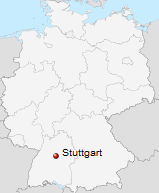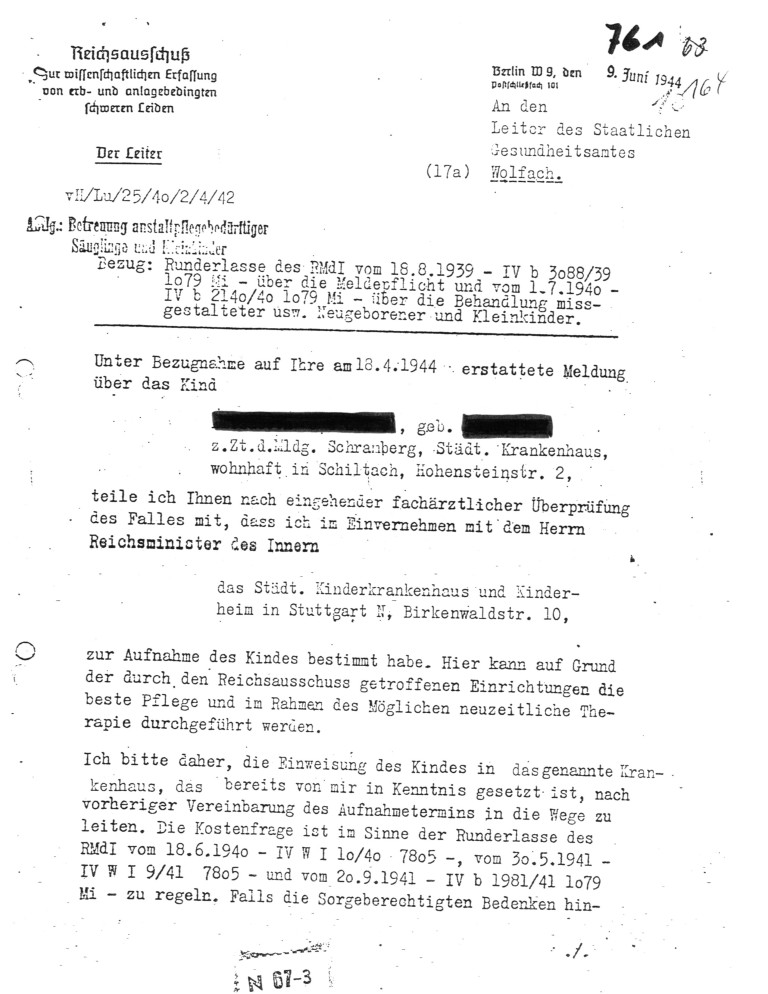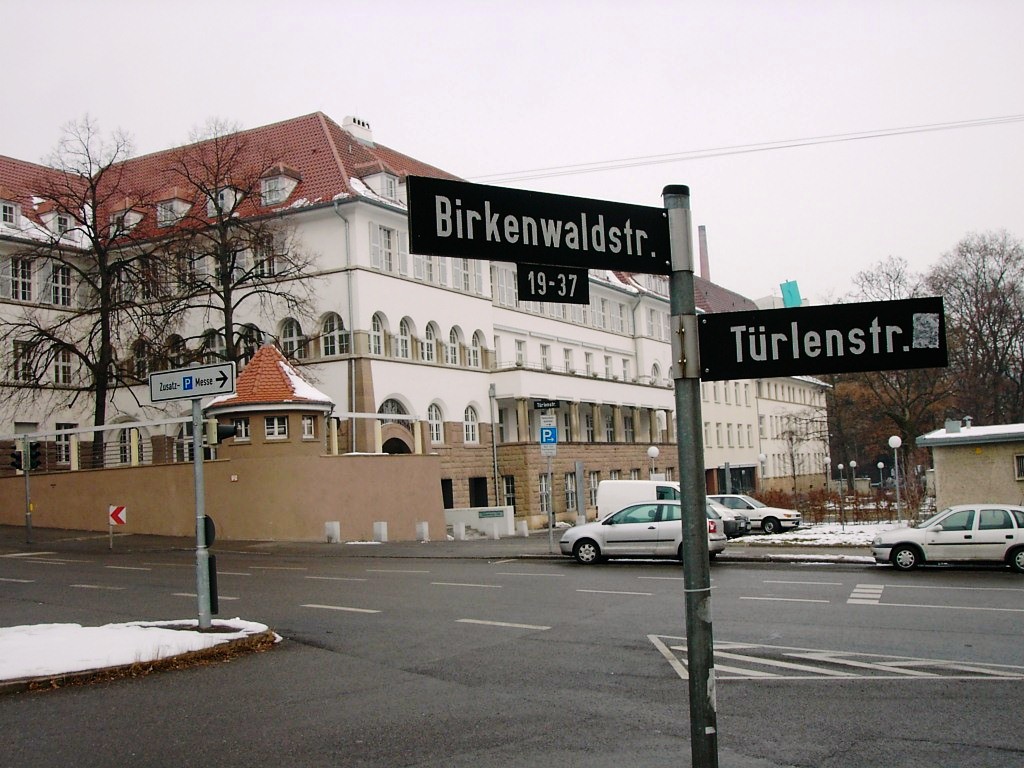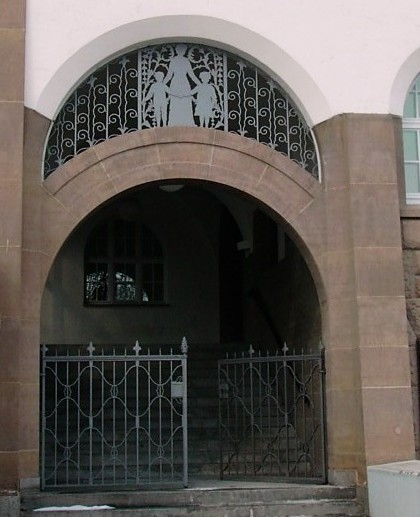Home
Stuttgart (Städtische Kinderkrankenhäuser und Kinderheime Stuttgart)

Current historical scholarship (see Topp 2004, 2005; also Benzenhöfer
2000) establishes the existence of a Kinderfachabteilung in Stuttgart
beginning January 1943 at
the latest until at least July 1944, if not the end of
WWII. The Städtische
Kinderheime und Kinderkrankenhäuser in Stuttgart consisted of a complex
of several
associated children's hospitals and homes and had their
administrative headquarters in the Birkenwaldstr. 10. The special
children's ward was not physically separated from other
wards but rather spread out over several facilities. Dr. Karl Lempp
was the clinic's director (he was also the city's deputy director
of the municipal public health department), and Dr. Magdalene Schütte
was responsible for the special children's ward.
Source: author.
Even though after WWII the American military government in Stuttgart
in 1946 suspected Dr. Lempp
"of having been involved in eliminating
people
with hereditary
disorders in collaboration with
Dr. Stähle
[as assitsant secretary responsible for medical
affairs in the Ministry of the
Interior in Wurttemberg],“ his proceedings before a German denazification
tribunal (Spruchkammerverfahren) resulted in his
classification of a "Mitläufer"
(passive follower), the second-lowest
category on a five-item scale of culpability. The committee saw
it as "proven that he had not been involved in the extermination of
unworthy life." In 1948 both Dr. Lempp and Dr. Schütte provided
testimony in the investigaton of the state prosecutor leading up to the
Grafeneck trial at the Landgericht Tübingen in 1949 against Dr. Stähle and Dr.
Mauthe (the former's highest medical
deputy in the Ministry of the Interior), in which the court held that
after preliminary communications in November 1942 between the two and
Dr. Hans Hefelmann and Richard von Hegener of the Reichsausschuss about
establishing
a special children's ward in Wurttemberg, the involved parties
"ultimately refrained from doing so," although the court established
that 93 children were transferred to special children's wards outside
of Wurttemberg (Bauer, p. 94). Thereafter Dr. Lempp remained deputy
director of the municipal
public
health department until 1949 and was director of the municipal
children's clinic until 1950, at year when he retired. He died in 1960.
Dr.
Schütte worked as a pediatrician in Aalen and was head physician of the
children's department of the regional hospital in Aalen between 1947
and 1956. In 1963 the state attorney's office in Stuttgart conducted
investigations against Dr. Schütte, which were terminated in the same
year.
While Ernst Klee, Udo Benzenhöfer, and Sascha Topp in their research
have argued for the existence of a special children's ward, Rolf
Königstein (2004) has strongly denied it. He documents the above
investigations and events and finds them to be exculpatory, even in
regard to the fact that at the time of the investigations against Dr.
Schütte in 1963, it had become known that she had signed on 30 June
1944 a request for Luminal from Dr. Widmann at the KTI (Topp 2005, p.
55. n. 272; with reference to BAB, R 58/1059, Bl. 64). He finds Dr.
Schütte's assertion credible that such requests were made to deceive
the Reichsausschuss, and he notes that neither Dr. Lempp nor other
clinic personnel received Sonderzuwendungen(special
allocations
for their involvement in the killing; Königstein,
p. 473). He does not mention, however, that such a deception is not
known to have been asserted as a defense of the charge of collaboration
with the Reichsausschuss in this matter in any other similar
circumstance, nor has
it been found credible by other scholars, and he does not seem to be
aware of the fact that not all of the directors of clinics with special
children's wards and their head physicians received such special
allocations.
Moreover, Peter Sandner (p. 536) reports that Dr. Schütte requested,
after consultation with Richard von Hegener [of the Reichsausschuss],
in
early 1943 to visit Eichberg "in order to get to learn its methods of
treatment." Eichberg, like Brandenburg-Görden, not only was the
location of a Kinderfachabteilung but also doubled up as training
facility where new
"euthanasia" physicians could learn their trade. Furthermore, a
document collected by the State Attorney's office in Gera in its
investigations against Rosemarie Albrecht (in Platz/Schneider, p. 81)
shows a correspondence from the Reichsausschuss to the public health
department of a city in Baden about a child to be admitted to the
Städtisches Kinderkrankenhaus und Kinderheim in Stuttgart,
Birkenwaldstr. 10. This documents alludes to the possibility that when
the state attorney's office explored the involvement of public health
departments in Wurttemberg in children's euthanasia in 1948-49, it may
not have taken account of the possibility that children from
territories adjacent to Wurttemberg were admitted to the
Kinderfachabteilung Stuttgart. In this context it should be noted that
for another clinic with a similar arrangement, i.e., a formally open
hospital with a decentralized killing ward whose children blended in
easily with the general hospital population, Dortmund-Aplerbeck,
post-war investigations erroneously concluded that no
children's ward had existed when in fact, as was discovered in the late
1980s, such a ward did exist and the
death of 162 children remains unexplained.
 Source: Platz/Schneider, p. 81.
Source: Platz/Schneider, p. 81.
The most convincing evidence for the existence of a Kinderfachabteilung
in Stuttgart has been marshalled by the physician Dr. Marquart (2008,
2009, 2011a-d). Based on his analysis of 506
extant
death certificates of children who died in the children's
hospital between January 1943 and the end of April 1945, he finds 52
suspicious deaths of children diagnosed with severe innate disorders -
but for which no causal relation to their death can be established. One
third of the children died of pneumonia, a typical result of poisoning
with Luminal. The death certificate was sometimes signed with a
fake name.
For a long time, apart from a recent stumbling block in Stuttgart-Vaihingen
for
Gerhard Durner, a child victim of "children's euthanasia" who died at
the Eichberg facility, there is no commemoration of children's
euthanasia in
Stuttgart - a city that harbored so many Nazi luminaries and
profiteers. A grandson of Dr. Lempp even threatened legal
action against Dr. Marquart and the publisher of the book Stuttgarter
NS-Täter.
In 2013 a stumbling block was placed for the child victim Gerda
Metzger. A youtube video is available: http://youtu.be/HoioDFctXbM? More information about the victim can
be found here.
Literature
Bauer, Fritz et al., eds. 1968-1981. Justiz
und NS-Verbrechen: Sammlung
deutscher Strafurteile wegen nationalsozialistischer Tötungsverbrechen,
1945-1966. Amsterdam: University Press Amsterdam. Vol. 5, p.
87ff.
Benzenhöfer, Udo. 2003. "Genese und Struktur der 'NS-Kinder- und
Jugendlicheneuthanasie.'" Monatsschrift
für Kinderheilkunde 151: 1012-1019.
"Karl Lempp." In Wikipedia.de. At http://de.wikipedia.org/wiki/Karl_Lempp.
Königstein, Rolf. 2004.
"Nationalsozialistischer „Euthanasie“-Mord in Baden und Württemberg."
Zeitschrift für Württembergische Landesgeschichte 63:381-489.
Marquart, Karl-Horst. 2008. "Gab es in Stuttgart
eine 'Kinderfachabteilung'?" Paper presented at the Frühjahrstagung des
Arbeitskreises zur
Erforschung der nationalsozialistischen 'Euthanasie' und
Zwangssterilisation, Grafeneck, June 2008.
———. 2009. "Karl Lemp: Verantwortlich für
Zwangssterilisierungen und 'Kindereuthanasie.'" Pp. 100-7 in Stuttgarter
NS-Täter: Vom Mitläufer bis zum
Massenmörder, edited by Hermann G. Abmayr. Stuttgart:
Schmetterling Verlag. Available here.
———. 2011a. "Die Stuttgarter Opfer der
NS-'Kindereuthanasie.'"Pp. 110-18 in Verlegt:
Krankenmorde 1940-1941 am Beispiel der Region Stuttgart, edited
by Elke Martin. Stuttgart: Verlag Peter Grohmann.
———.
2011b. "Obermedizinalrat Karl Lempp, verantwortlich für
Zwangssterilisierungen und die 'Euthanasie' von Kindern." Pp. 124-32 in
Verlegt: Krankenmorde 1940-1941 am
Beispiel der Region Stuttgart, edited by Elke Martin. Stuttgart:
Verlag Peter Grohmann
———. 2011c. "Untersuchung über Stuttgarter Opfer der
NS-'Kindereuthanasie.'" Pp. 165-174 in Den
Opfern einen Namen geben: NS-"Euthanasie"-Verbrechen,
historisch-politische Verantwortung und Erinnerungskultur.
Munster: Klemm und Oelschläger.
———. 2011d. "'Kindereuthanasie' in Stuttgart:
Verdrängen statt Gedenken?" Pp. 145-168 in Kindermord
und "Kinderfachabteilungen" im Nationalsozialismus: Gedenken und
Forschung, edited by Lutz Kaelber and Raimond Reiter. Hamburg:
Lang.
Platz, Werner E., and Volkmar Schneider, eds. 2008. Dokumente einer Tötungsanstalt: "In den
Anstalten gestorben." Vol. 2. Hentrich und Hentrich.
Sandner, Peter. 2003. Verwaltung
des Krankenmordes. Der Bezirksverband Nassau im Nationalsozialismus.
Giessen: Psychosozial-Verlag.
Topp, Sascha. 2004. “Der ‘Reichsausschuss zur
wissenschaftlichen
Erfassung erb- und anlagebedingter schwerer Leiden’: Zur Organisation
der Ermordung minderjähriger Kranker im Nationalsozialismus 1939-1945.”
Pp. 17-54 in Kinder in der
NS-Psychiatrie, edited by Thomas Beddies and Kristina Hübener.
Berlin-Brandenburg: Be.bra Wissenschaft.
———. 2005. "Der 'Reichsausschuß zur wissenschaftlichen Erfassung erb-
und anlagebedingter schwerer Leiden': Die Ermordung minderjähriger
Kranker im Nationalsozialismus 1939-1945." Master's Thesis in History,
University of Berlin.





 Source: Platz/Schneider, p. 81.
Source: Platz/Schneider, p. 81.